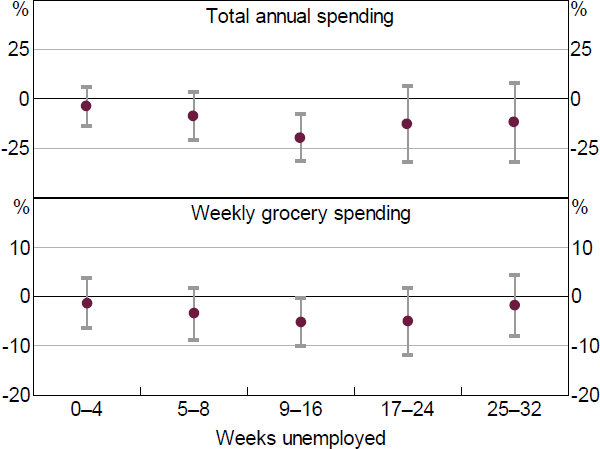RDP 2021-08: Job Loss, Subjective Expectations and Household Spending 7. Sampling Bias in Household Surveys
August 2021
- Download the Paper 2,109KB
A significant challenge in estimating the household spending response to unemployment using survey data is that unemployed survey respondents may not represent the ‘typical’ (or average) unemployment spell. In particular, the spell of unemployed survey respondents is generally longer than a typical spell (Salant 1977). This is because shorter spells are more likely to be ‘missed’ by the survey, as they occur in between waves. If the consumption response to unemployment varies with duration, then the estimates of consumption losses associated with unemployment may be biased and not representative of the typical unemployment experience.
This sampling bias is common to studies that try to identify the effect of unemployment on spending using survey data. To the best of our knowledge, there are few studies that attempt to address this issue, despite the fact that information on the length of unemployment is often available in longitudinal household surveys, such as the HILDA Survey.
To explore the importance of this sampling bias, we test if the spending response to unemployment varies with how long the unemployed respondent has been reportedly searching for work. To do this, we re-estimate Equations (1) and (2) but include interaction effects for unemployment with ‘buckets’ of unemployment duration (e.g. 0–4 weeks, 5–8 weeks, etc).
We find that the consumption losses are larger for survey respondents that report being unemployed for longer spells at the time of the survey (Figure 18). Consumption losses are only statistically significant for those that have been unemployed for longer than a couple of months. This may imply that unemployment duration matters for a household's ability to smooth consumption over spells, or because workers who stay unemployed for longer are systemically different in ways that affect spending (such as wealth, household income, etc).
In summary, our estimates of consumption losses capture the effect of unemployment on the typical unemployed worker at a point in time. But our results may overstate the consumption losses associated with a typical unemployment spell given this is not the same concept. For instance, we do not capture the effect on respondents that are unemployed between survey waves, who are typically unemployed for shorter spells than the survey respondents that are observed to be unemployed. Having said this however, over-weighting the consumption falls of workers who remained unemployed for longer is appropriate for the purpose of capturing the aggregate effect of unemployment on aggregate spending.

Note: Lines represent 95 per cent confidence intervals
Sources: Authors' calculations; HILDA Survey Release 19.0